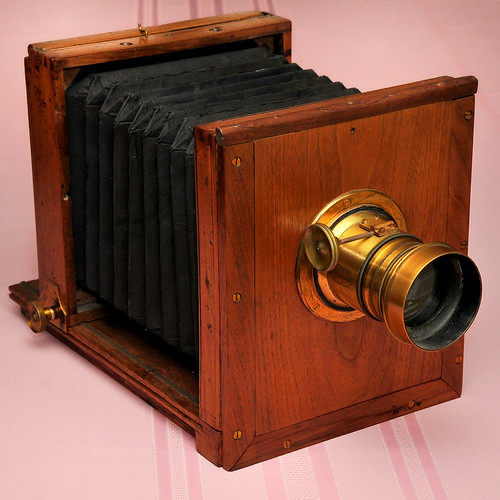Difference between revisions of "Wet-collodion"
m (Changed caption again to make image_by page for the photographer on 2nd thoughts) |
m (Added image_by cat manually) |
||
| Line 41: | Line 41: | ||
** [http://www.earlyphotography.co.uk/site/entry_C80.html G.J. Bourdin Dubroni No. 1, c.1867]; wet plates were developed, fixed and washed ''in'' this camera! | ** [http://www.earlyphotography.co.uk/site/entry_C80.html G.J. Bourdin Dubroni No. 1, c.1867]; wet plates were developed, fixed and washed ''in'' this camera! | ||
** [http://www.earlyphotography.co.uk/site/entry_H7.html Dark tent] for wet plate development. | ** [http://www.earlyphotography.co.uk/site/entry_H7.html Dark tent] for wet plate development. | ||
| + | |||
[[Category: Photographic processes]] | [[Category: Photographic processes]] | ||
| + | [[Category: Image by National Maritime Museum]] | ||
Revision as of 13:06, 11 May 2011
| ||
|
The Wet-Collodion (or wet-plate collodion) process is a negative-positive photographic process using potassium iodide dissolved with collodion - a solution of gun-cotton in ether. Gun-cotton is made by treating cotton wool (almost pure cellulose) with nitric acid, producing nitro-cellulose. Nitro-cellulose was later used as a flexible base material for film; in the wet collodion process, it does the job that gelatine does in modern film; it contains the light-sensitive material, in a layer permeable to chemical solutions.
The potassium iodide/collodion solution is spread onto glass plates, where the ether evaporates. Before the ether completely evaporates, the plates are sensitized in a bath of silver nitrate solution. The plate had to be loaded into a dark slide and exposed while still wet, so the plate preparation had to be done immediately before use (once dry, the collodion would not be permeable to the developing solution[1]). This meant that outside the studio, photographers had to carry a small tent with a supply of plates, sensitization bath and bottles of the solutions. However, the process was popular in part because the plates were considerably more sensitive than other existing media, allowing shorter exposure times, which in particular made portrait photography more convenient.[1]
The process was invented in 1850, and published in 1851 by Frederick Scott Archer, although a Frenchman, Gustave Le Gray may have discovered the process at around the same time.
Notes
- ↑ 1.0 1.1 National Media Museum Information Sheet Photographs on Glass.
Links
- Wet Plate Collodion Forum
- Collodion Process on Wikipedia
- Getting Started in Wetplate Collodion Photography by Joseph Smigiel on Unblinking Eye.
- Lewis Carroll's wet-collodion outfit and a portable sensitizing tank for collodion plates in the catalogue of an exhibition Cameras: the Technology of Photographic Imaging at Museum of the History of Science, Oxford 20 May - 13 September 1997.
- Wet-plate equipment on Early Photography:
- Horne & Thornthwaite sliding-box camera, 1857
- Dallmeyer stereo wet-plate camera, 1863
- Dallmeyer bellows camera for wet and dry plates, 1882
- G.J. Bourdin Dubroni No. 1, c.1867; wet plates were developed, fixed and washed in this camera!
- Dark tent for wet plate development.

